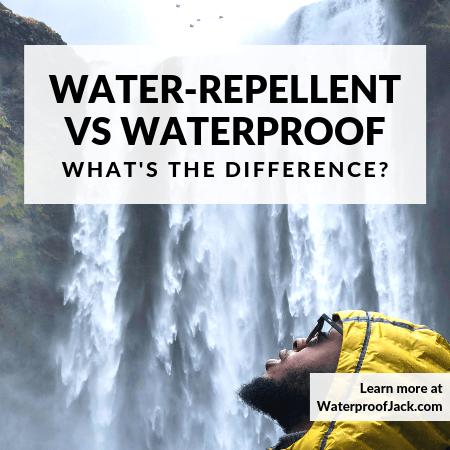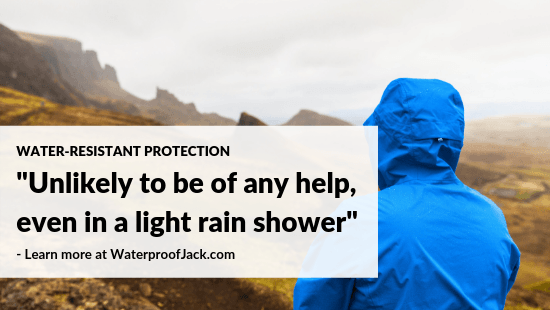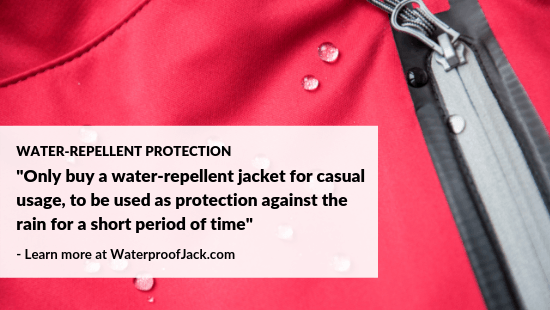
Have you ever bought a new jacket - only to be caught out by a downpour to find that it doesn't keep the rain out? Not all jackets have the same level of water protection. Crafty manufacturers are experts at giving their jackets names and 'technologies' that sound like they are the best at keeping the rain out. To avoid an unhappy surprise, you should look out for three widely used terms: 'water-resistant', 'water-repellent' and 'waterproof'.
What's the difference between water-resistant, water-repellent and waterproof?
Water-resistant
The most basic of protection, if a jacket is labelled water-resistant then it is unlikely to be of any help, even in a light rain shower. We do not recommend that you buy a jacket labelled water-resistant. Often jackets with this labelling are tightly woven fabrics that offer a degree of protection by being a barrier between you and the rain. The materials have in no way been treated to improve their protection, however you can purchase products to treat your garments, turning them from water-resistant to water-repellent. This type of waterproof labelling is most common on watches or cameras to imply that they have been built in a way that protects their functional components against minor water contact.
Water-repellent
A more common label for jackets is water-repellent, a small step up from water-resistant, it may just do the job in a rain shower. We recommend that you only buy a water-repellent jacket for casual usage, to be used as protection against the rain for a short period of time. Water-repellent jackets are usually lightweight and are often given their protection by the application of a surface coating. This surface coating is to encourage water to form droplets and to flow off before it seeps deeper into the jacket (the technical term is that it’s hydrophobic). Sprays and washing liquids can be commonly found at outdoor specialists to make your jacket water-repellent.
Some jackets are both water-repellent and waterproof, meaning they have both a treated surface and a waterproof membrane.
Waterproof
A waterproof jacket is certainly the way to remain dry in a rain shower. A waterproof jacket contains a water-tight material known as a waterproof membrane with only microscopic pores; big enough to release moisture created by your body but small enough to prevent rain droplets from getting through.
Did you know that there are different grades of 'waterproof'? Look out for the waterproof grade label, which could look something like: 5k (5,000mm), 10k (10,000mm), 15k (15,000mm) and 20k (20,000mm). The higher the number, the more waterproof the jacket. This is the result of the jacket's hydrostatic head test. Any quality manufacturer will clearly state the grade of waterproofing a jacket provides, if the grade isn't labelled, be cautious about making a purchase.
Waterproof 3,000mm - 5,000mm
a basic level of protection for casual usage
Waterproof 5,000mm - 10,000mm
a moderate level of protection for casual usage
Waterproof 10,000mm - 15,000mm
a good level of protection for casual usage
Waterproof 15,000mm - 20,000mm
We classify 15,000mm - 20,000mm jackets as a moderate level of protection for active usage. This level of protection would be sufficient for snowboarding/skiing in dry snow conditions or for a short to medium length hike in the rain.
Waterproof 20,000mm+
A waterproof jacket with 20,000mm+ waterproofing is in the top tier of protection from the elements. We classify 20,000mm+ jackets as a good level of protection for active usage, such as: snowboarding/skiing in wet snow conditions or long hikes in bad weather. There are not a great number of jackets on the market with this level of waterproofing, they are often more expensive than people are willing to pay for a casual jacket. If you are looking at jacket with a grading higher than this, you're probably looking to start your career as part of a trawler crew.

